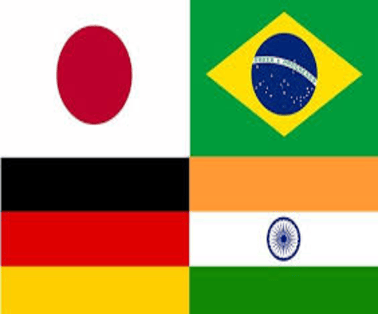India, on behalf of the G4 Nations—Brazil, Germany, Japan, and India—has presented a detailed and flexible proposal for United Nations Security Council (UNSC) reform, marking a significant step toward restructuring the global security body. The proposal was introduced by India’s Permanent Representative to the UN, Ambassador Ruchira Kamboj, during the Inter-Governmental Negotiations (IGN) on March 7.
India’s Push for UNSC Reform on Behalf of G4 Nations
- India’s Permanent Representative to the UN Ambassador Ruchira Kamboj presented the ‘G4 model’ on behalf of Brazil, Germany, Japan and India for debate, dialogue and finally negotiations.
- Participating in the Inter-governmental Negotiations on Security Council reform (IGN) on March 7, India’s Permanent Representative to the UN Ambassador Ruchira Kamboj said the UN’s 80th anniversary next year serves as a milestone to achieve concrete progress on the long-pending subject.
- “The realities of 1945, when the Council was established, have long been superseded by the geo-political realities of the modern era and a new century; with the need for change being felt across the board,” Ms. Kamboj said as she shared the exhaustive G4 model with UN Member States in the General Assembly.
Key Features of the G4 Nations’ Model for UNSC Reform
- The G4 model proposes that the Security Council’s membership increase from the current 15 to 25-26, by adding six permanent and four or five non-permanent members.
- Among the six new permanent members, two each are proposed to be from African states and Asia Pacific states, one from Latin American and Caribbean states; and one from Western European and Other states.
- The G4 model notes that the current composition of the Security Council, with its “glaring under-representation and un-representation” of key regions in both categories of membership, is “detrimental” to its legitimacy and effectiveness
- But the G4 model “does not specify” which member states will occupy the new permanent seats. “This decision will be made by the General Assembly in a democratic and inclusive election.
- In a departure from the existing framework where only the five permanent members hold veto powers, the G4 model offers flexibility on the veto issue.
- New permanent members would refrain from exercising the veto until a decision on the matter is taken during a review process, demonstrating a willingness to engage in constructive negotiations.
- The proposal emphasizes that the decision on which member states will occupy the new permanent seats will be made through a democratic and inclusive election by the UN General Assembly
Issues Associated to Functioning of UNSC
-
Regional representation
- Supporters of UNSC reform claim that there is a huge European bias in P-5 due to the presence of the United Kingdom and France including Russia.
- While regions like Latin America, Caribbean group, Arabs and Africa do not have a single permanent member. Similarly, there is a western bias in UNSC.
- Thus, a large chunk of the population and many different regions of the world remain unrepresented in the permanent membership of UNSC.
- It seems highly unfair that the whole continent of Africa does not have a single member in P-5 despite the fact that most of the affairs of the body concern this part of the globe only.
- So, regions like Africa and Latin America and others will have to be accommodated in the reformed UNSC.
-
Changing geopolitics
- The victors of World War II shaped the United Nations Charter in their national interests, dividing the permanent seats, and associated veto power, among themselves.
- It has been many years since the foundation of UNSC.
- During this period, the geopolitical realities have changed drastically, but the Council has changed very little.
-
Divisions Among the P5
- There is a deep polarisation within the UN’s membership, so decisions are either not taken, or not heeded.
- Frequent divisions within the UNSC P-5 end up blocking key decisions.
- These issues can be manifested in the example of the emergence of the coronavirus pandemic where the UN, the UNSC, and WHO failed to play an effective role in helping nations deal with the spread.
-
Recognition of Contributions
- The UN Charter acknowledges that countries making substantial contributions to the organisation should have a role in the Security Council.
- This recognition underscores the candidacy of nations like India, Germany and Japan for new permanent seats, reflecting their meaningful contributions to the UN’s mission.
Challenges Facing the G4 Nations’ UNSC Reform Proposal
- The P-5 will never agree to give up their veto right, nor will they agree to accord this right to any other country
- United States and China are opposed to any major restructuring
- United Kingdom has supported G-4 as new permanent member without Veto power
- Thre is lack of unity and difference of views in terms of reform agenda among G-4 members also their regional rivals are opposed to the G-4 becoming permanent members.
- Any changes in the structure of UNSC will require amendment in the UN charter that will have to be signed and ratified by two third majority of UNGA membership and it will also require concurrence of current P-5 members. Veto of even one permanent member can do away with Indian dream.
- General membership of the UN wants to eliminate the existing veto; they will never agree to new veto-wielding powers.
- China is most likely to block India s and Japan s bid for permanent seat considering its border disputes with these two nations
- There are pressure groups within UN such as Uniting for consensus (Ufc) who are against any expansion in the permanent membership with veto power
- Civil society, the most effective engine of change has not been actively engaged in UNSC reform to any meaningful extent
United Nations Security Council
- The United Nations Security Council, established under the UN Charter in 1945, constitutes one of the UN’s six principal organs.
- Comprising 15 members, it includes 5 permanent members (P5) and 10 non-permanent members elected for two-year terms.
- The permanent members are the United States, Russian Federation, France, China, and the United Kingdom.
- India’s participation in the Security Council has been as a non-permanent member during the periods of 1950-51, 1967-68, 1972-73, 1977-78, 1984-85, 1991-92, 2011-12, and 2021-22.
Conclusion
The proposal by India on behalf of the G4 Nations signals a determined and forward-looking effort to bring much-needed reform to the United Nations Security Council. By offering a balanced approach that includes regional representation, democratic elections, and flexibility on the veto, the G4 model lays a foundation for a more inclusive and representative global security architecture.
As the UN’s 80th anniversary approaches, the momentum for reform must not be lost. The time is ripe for the international community to support meaningful changes that align the UNSC with 21st-century realities.
To Download Monthly Current Affairs PDF Click here
Click here to get a free demo
Discover all about CLAT Exam



